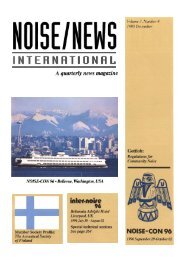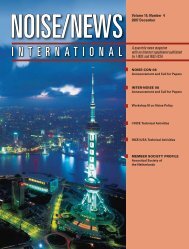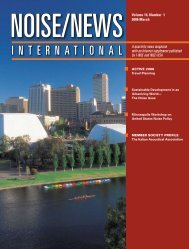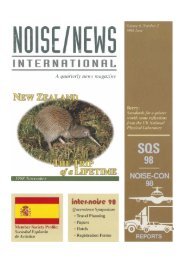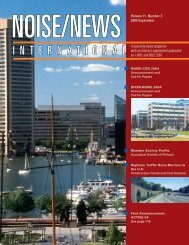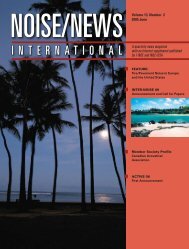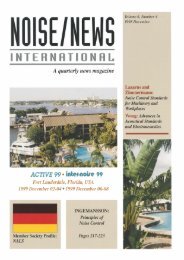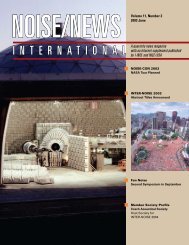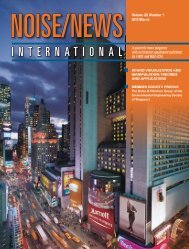Download - Noise News International
Download - Noise News International
Download - Noise News International
- No tags were found...
You also want an ePaper? Increase the reach of your titles
YUMPU automatically turns print PDFs into web optimized ePapers that Google loves.
and passive level-dependent hearingprotectivedevices and said that there aremany technical challenges involved indeveloping new standards.Ten parallel sessions continued throughthe morning.The third plenary lecture was given inthe afternoon on Monday, August 8. Thepaper was presented by Thais C. Moratafrom the Division of Applied Research andTechnology of the National Institute forOccupational Safetyand Health in theUnited States. Thetitle of the paper was“Health Effects of<strong>Noise</strong> Interactionsat Work, Leisure,and Home.” Inmost studies ofhealth effects, noiseis treated alone,and the combined Thais Morataeffects of noise presents the thirdand some otherplenary lecture.agent are not always considered, andthe effects of a combined exposure arenot always predicted from each agentacting alone. The National Institute forOccupational Safety and Health (NIOSH)began a program in 1966 on researchon mixed exposures, and there is at theNIOSH website a research agenda formixed exposure for the year 2005. Shesaid that noise interactions at home are themost likely for disturbance and that nonauditoryeffects are known, for example,because of metabolic changes from therelease of stress hormones. She said thatthe information conveyed by noise is oftenmore important than the level itself andthat transportation noise has the most effectfor people at home. She cited severaleffects of noise and the relevant references.These include exposure to traffic noisewhich can be perceived as a potentialdanger and thus result in an increase instress hormones. She said that there is arelationship between high annoyance andheart disease and also that skin disease canbe related to increased levels of noise andair pollution. In schools, there are knownlearning disorders caused bynoise, and she said that manyleisure activities are affectedby noise. Most recently, shesaid, there is an interactionbetween noise levels andlead related to firearms andthat, in the motor sport area,noise and vibration levels cancombine with other chemicalsto produce toxic effects.She next turned to noiseinteractions at work and saidthat work is the setting where noiseexposures can be higher and moreconsistent than in any other setting. Shediscussed some of the endogenous factorsthat can have a combined effect with noise.These include age, body temperature, stressactivity, and others. She said there are alsoexogenous factors which include smoking,vibration, ambient temperature, use ofmedicines, and exposure to chemicals. Thenew European Community (EC) directiveon noise (2003/10/EC) requires that theinteraction between noise and oto-toxicchemicals be taken into account in the riskassessment of exposed populations.How did we get where we are, shequestioned? She said it was through nonauditoryeffect of noise and vibration,including whole body vibration and handarmvibration through the white-fingersyndrome and through hearing loss. Thehistory of these combined effects begins inthe 1980s, although there were only isolatedreports and no systematic studies. Duringthe 1980s some initial results from Swedenwere available and seminal papers werepublished. NIOSH became interested in thisproblem in 1988, and many of the NIOSHpublications of the 1990s are online.She cited other situations in Canada andKorea where carbon monoxide intoxicationhas affected farmers and pesticides to thepoint where farmers have more hearing…work is the settingwhere noise exposurescan be higher and moreconsistent than in anyother settingloss than the general public. She said thatshe had published evidence in 1993 of theinteractions between noise and solvents.She cited recommendationsby the American Conferenceof Governmental IndustrialHygienists (ACGIH) thatcaution that one shouldpay attention to exposureto various chemicals whenconsidering the effectsof noise. The U.S. Armyalso requires considerationof oto-toxic chemicalexposures when dealingwith hearing loss.She concluded by saying that many ofthese effects of combined exposures arenot taken into account in many studies andthat one should take a medical history, ahistory of chemical exposure, and otherfactors when studying the effects of noiseon hearing.Ten parallel sessions continued throughthe afternoon.The next distinguished lecture was byMichael Vorländer of the Institute ofTechnical Acoustics, Aachen Universityin Germany on Tuesday morning, August9. The title of his presentation was“EngineeringAcoustics MeetsAnnoyanceEvaluation.” Hepointed out thatmany of thedaily problemsin engineeringacoustics usesingle-numbercriterion for theirsolution. However,he said, one mustMichael Vorländerpresents the fourthplenary lecture.consider such things as sound quality andsound as a carrier of information as well aswho creates the sound. Thus, engineeringacoustics must involve both single-numbercriteria and some sort of simulation and2005 December www.inceusa.org • www.noisenewsinternational.net • www.i-ince.org125



